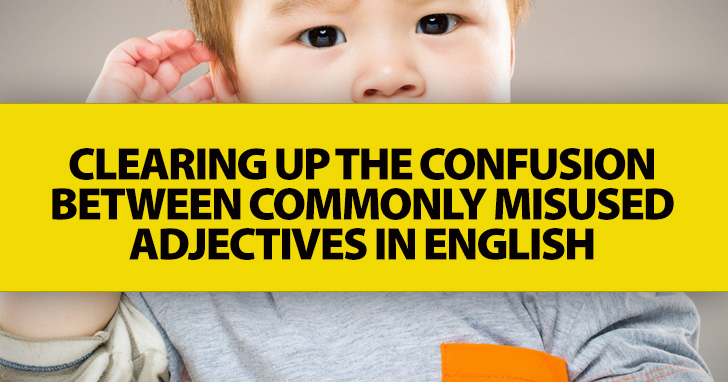Much or Many? Few or a Few? Clearing up the Confusion between Commonly Misused Adjectives in English


Here’s why they can get confusing and what your students need to know to keep them straight.

ESL students can confuse these words because of their similar pronunciation. Accept is a verb which means to take it as reality or truth. I accept your apology. Except is a preposition which means to leave out or not include. I like all vegetables except beets. Point out that they are different parts of speech which serve different functions in the sentence.
These two words (three to be technical) can be confusing for ESL students because they sound the same. Allot is a verb which means to divide and assign amounts to certain groups of people. I have allotted $50 for each child’s Christmas presents. A lot describes a large quantity of something. I have a lot of food ready for the party. Help your students remember the difference when they see in writing that a lot is actually two separate words.
ESL students can confuse these words because they are both prepositions with similar spelling and pronunciation. Beside is a preposition which means next to or adjacent to. The keys are beside my coffee cup. Besides is a preposition which means in addition to. I have several errands to do besides picking up the dry cleaning. You can help your students remember the difference with this trick: besides is beside with an added s and means one thing in addition to another.
ESL students can confuse these words because they both involve having something in your possession. Bring is a verb which means to take something you already have with you. Make sure you bring your book to class. Take is a verb which means to put something that was not yours before into your own possession intentionally. He took the smallest piece of cake. Explain the difference by pointing out that bring includes the idea of moving something from one place to another while take implies the idea of permanent ownership.
ESL students can confuse these words because of their similar meaning and pronunciation. Cloths and clothes are both plural nouns. Cloths refers to pieces of fabric often used for cleaning or other chores while clothes are the sewn pieces of fabric a person wears on their body. The spelling and pronunciation of these two words can be tricky. Remind your ESL students that a word ending in ths will have th as an unvoiced sound (th as in think or throw) and that a thes at the end of a word will make the voiced th sound (th as in those or the).
These words can be confusing because they seem to refer to the same thing but don’t. Everyday is an adjective which refers to something that occurs every day or something that is normal. This is just an everyday assignment, nothing special. Every day is a reference to a time which includes each day in a specified period. We get a homework assignment every day. Help your students remember the difference by pointing out that everyday is an adjective meaning ordinary while every day is a noun phrase. It contains the word day and is a reference to time.
Fewer and less can be confusing to ESL students because they have a similar meaning. Fewer is an adjective meaning a lesser amount. She has fewer pets than me. Less is an adverb which means to a smaller extent or degree. She is less coordinated than he is. Help your students by stressing that these words serve as different parts of speech and that fewer is often used with count nouns while less is often used with noncount nouns.
Give and take are words that can be confusing to ESL students because they describe the same process but from different perspectives. Give is a verb which means to present voluntarily or hand over something. I will give presents to all my nephews at Christmas. Take is a verb which means to receive something into your possession. I will take the leftovers home with me. To help your ESL students keep the words clear in their minds, stress the performers of each action. Person A gives to person B. Person B takes from person A. The one who takes the item has it in their possession at the end of the action.
Like other confusing word pairs, good and well have similar meanings and are therefore easily confused by some ESL students. Good is an adjective which means excellent or right. The movie was really good. Well is an adverb which means in a good manner. The actors performed well in the movie. Help your students keep the two words straight by stressing the different parts of speech that each word functions as.
Learn and teach can be confusing to ESL students because they refer to the same process but from different perspectives. Teach is a verb which means to give information to one or more students. I teach English grammar and writing. Learn is a verb which means to receive information. I am learning how to speak English at the University. Help your students remember the difference by stressing that while the two words refer to the same event, they only refer to one person’s actions during the process.
Lend and borrow can be confusing to ESL students because, like other pairs of confusing words, they refer to the same process but depend on who performs the action. Lend is a verb which means to give something to someone else temporarily. I will lend you my notes since you missed class. Borrow is a verb which means to take something from someone else temporarily. I will borrow them for tonight and give them back tomorrow. To help your students keep these words straight, make sure they understand that in one event, one person lends and the other person borrows. The person who lends is the one who owns the item.
Many and much can be confusing to ESL students because they have similar meanings. Many is an adjective meaning of a large number. I have many ideas for the presentation. Much is an adjective or adverb meaning a great quantity. You put too much pepper in the soup. Help your ESL students know the difference between the words by pointing out that many is often used with count nouns while much is often used with noncount nouns.